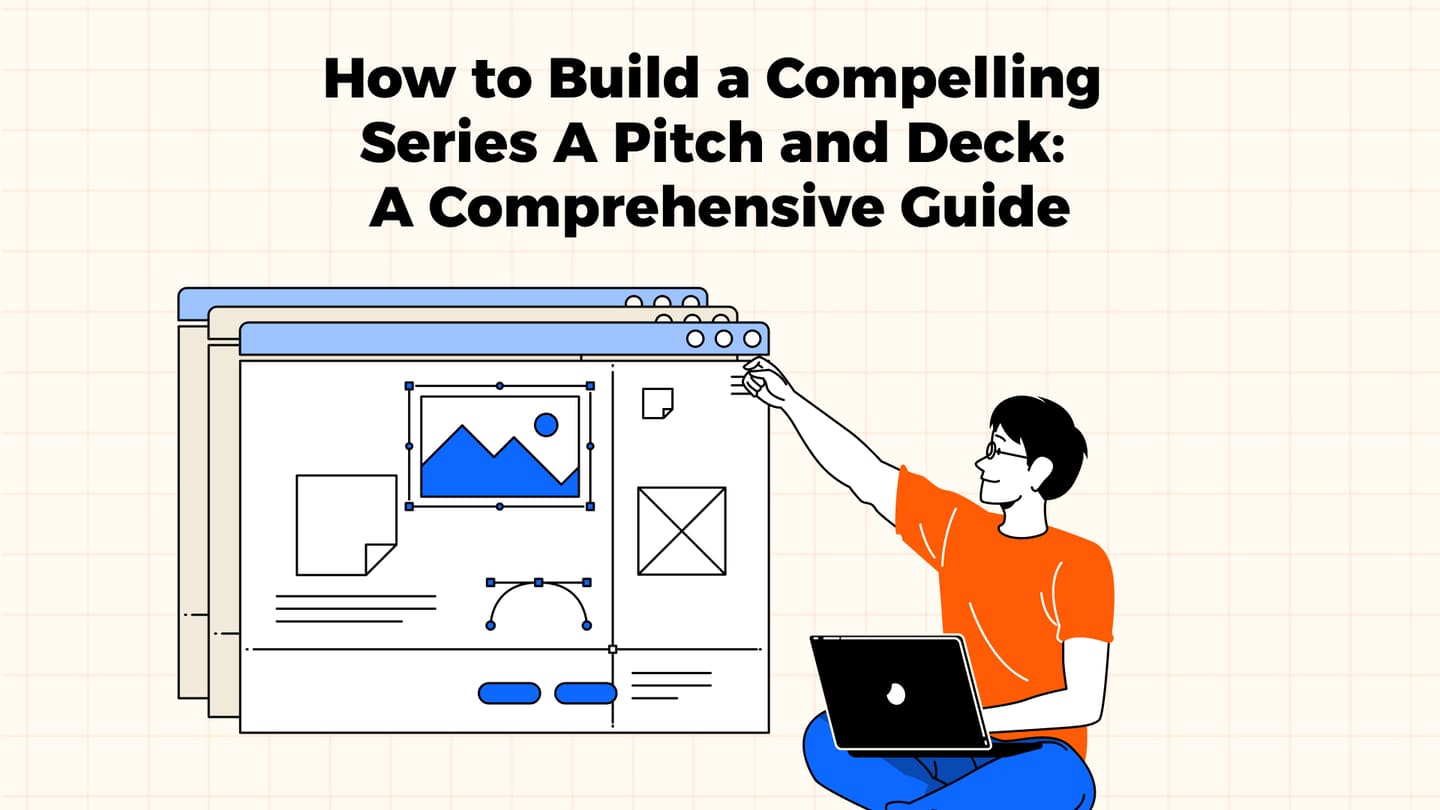
How to Build a Compelling Series A Pitch and Deck: A Comprehensive Guide

What is a pitch deck for investors? Many would say that it is a perfect opportunity to introduce your innovative product and make sure it hits the shelves through secured funding. However, each type of presentation differs tremendously from the previous one.
The Series A funding round goes beyond the financial aspects of the venture. It's your golden opportunity to showcase your startup's potential to the fullest. It takes skill and effort, not to mention time and expertise, to create a compelling narrative that relies on your vision, unique proposition, and business potential.
A success-oriented Series A pitch deck, at its core, is quintessential of your project. While it contains a fair share of numbers and statistics, it relies on strategic persuasion and paints a vivid picture that resonates with the investor pool. You shouldn't design it with a primary emphasis on fund securing but show the viewers that there's more to learn and drive them to crave more information on your startup.
Surely, it sounds like a tough task to deal with on your own, especially if you are new to the scene. WhitePage experts have compiled a comprehensive Series A guide for you to grasp the notion on a deeper level and create a result-driven presentation.
Who wants to learn more?
Understanding Series A Funding
A well-crafted series A deck is multi-layered and complex, but you shouldn't skip on the basics.
Definition of Series A Funding: Explain what it is and how it differs from seed funding

Every startup goes through different stages of development before it transforms into a blooming business. The seed stage is where you present your idea and seek funding for further development, research, and marketing purposes. The Series A round is centered on growing your startup, including but not limited to hiring more employees, designing additional products, and moving on to other markets.
Professional presentation deck design services are fully aware of the fact that seed funding requires smaller investments but encounters more risks. Series A funding fishes out for more substantial investments, and the risks involved are somehow lower due to previous achievements.
Keep in mind that each stage is equally important, and one can't go without the other.
Why It's Crucial: The significance of Series A in scaling a startup
It is easy to underestimate the ultimate importance of a dedicated series A presentation without real-life startup pitch deck examples and some 6-figure investments to inspire from, isn't it?
In 2011, the company raised its primary Series A funding from Benchmark Capital and First Round Capital. Uber raised $11 million during the negotiations. The money was spent on market expansion.
The company's Series A funding deck helped the startup raise $5 million from different investors, including Andreessen Horowitz and Accel.
The cybersecurity project achieved $543 million in investment through an effective series A funding round.
Starting with a Strong Narrative
What is an investor deck without a strong narrative interwoven in it? It is a waste of time.
Crafting Your Story: How do you weave a coherent, compelling story?

Even the most captivating story needs a good structure to keep the investor involved. Whitepage pitch deck design agency suggests a couple of storytelling principles you may want to exploit when working on your deck.
Beginning-Middle-End
The rules are simple: describe the problem (beginning), provide your unique solution (middle), and enlist all the future goals and perspectives(end). If we take Uber, for example, in their presentation, they began with the pain of unreliable transportation. After that, they suggested a solution in the form of their on-demand service and finished the story with how convenient, reliable, and requested their project would become.
The Hero's Quest
This story frame is designed to paint your service or product as a hero dealing with a pressing issue. As you deal with the matter, you take the viewers on a breathtaking adventure, conquer new horizons, deal with all sorts of obstacles, and finalize the crusade with unquestionable benefits that future clients and potential investors won't be able to resist.
For instance, Airbnb became a hero who overcame the stressful challenges of finding affordable accommodation and heavily sprinkled the scene with unparalleled hospitality.
Key Questions to Address: What problem are you solving? Why now? Why you?

The storyline principles will do you any good as long as you build your presentation on the right pillars. As you work on your narrative, try to address the following questions:
- What are the pain points you plan to attend to?
- How does your solution fit into the current market landscape? Is it timely? Why?
- What makes you stand out?
- Why do you care about this particular problem?
- What are your main strategies?
- How scalable is your solution?
Essential Slides for a Series A Pitch Deck
How to structure a series A capital raise pitch deck so that it drives viewer interest and potential funding opportunities up? Let's discuss the main presentation slides in detail.
Problem Slide: Highlighting the problem in the market

A problem slide should draw attention to a problem or pain point that you aim to fix. It is mandatory to present the challenge clearly, provide relevant statistics, and establish an emotional bond with the audience. You can incorporate visuals to emphasize the importance of the matter.
It is critical to filter any sort of irrelevant information so as not to distract or mislead the viewers. Also, you must keep the slide simple and concise, or you may shift the focus. Lastly, make no assumptions if you can support them with actual data, no matter how lucrative the statement sounds.
Solution Slide: Your product/service as the solution

As your Problem slide sets the stage for the unique solution you offer, WhitePage experts suggest that you center your Series A funding pitch deck around the direct impact your product will have. You can showcase all the innovative approaches you are going to apply, highlight unique features, and present your Unique Value Proposition(USP). It may be an excellent choice to support the claims with relevant visuals. However, the main focus should be on your target audience and how your solution benefits them.
You mustn't overweigh the slide with jargon, vague or generic information, and straight-off bragging.
Market Size: Addressing the Total Addressable Market (TAM), Serviceable Available Market (SAM), and Serviceable Obtainable Market (SOM)

Your product is as good as the marketing opportunities it offers. Thus, the Market Size slide aims to indicate your scalability. It would be false to assume that your service can cover the whole market landscape. Yet, you can single out a segment of the Total Addressable Market (TAM), aka Serviceable Available Market (SAM), and pinpoint the realistic part of it you can cover – Serviceable Obtainable Market(SOM).
As you do so, it would be wise to base your presentation on reliable reports and research to prove that you know what you are talking about. Once again, you can refer to relevant visuals to support your story. You can even go as far as to make mild predictions if possible.
What you shouldn't do would be to set unrealistic goals and claims. Also, you mustn't underestimate the impact of market segmentation and incorrect data.
Business Model: How you make money

Ask any financial modeling consulting services, and they will answer – compelling Series A pitch deck examples usually include a business model slide. It is the best way to show your project's profitability. You can highlight main revenue streams, individualized price policy, strategic approach, Customer Acquisition Cost, and potential collaborations and partnerships aimed to boost your business potential.
At this stage, you must operate numbers, but you should try to deliver them in the simplest way possible. It is critical that you find a balance between overcomplication and oversimplification.
Traction Slide: Proof of product-market fit, growth metrics, customer feedback

The theoretical approach isn't enough to convince your future investors. Thus, it takes a quality Traction slide to showcase your current progress. Spice your traction slide with available user metrics, financial data, client feedback, and partnerships, if any, to indicate your credibility and future potential.
The best Series A decks stir clear of any vague or irrelevant information. You should focus on growth and retention stats instead of going back to initial startup metrics. The same goes for exaggeration. No matter the urge to blow up your bubble even a tad, you should stick to accurate details.
Marketing and Sales Strategy: Your plan to acquire and retain customers

Even the best startup idea will go to waste if there are no people who will benefit from it. That's why most Series A deck examples contain a Marketing&Sales strategy slide. The primary goal of the slide is to define your target audience, show how you are going to convert new clients, and how you plan to keep them loyal to your product or services. Some presentations go as far as visualizing the whole customer journey to prove that their strategy is effective.
While this part of the way seems straightforward enough, our experts recommend that you stir clear of empty generalization and excessive detail. This does not mean that you should ignore relevant metrics. Just bring the critical indicators to the front.
Financial Projections: Projected revenue, costs, profits

A successful series A deck template should contain a lucrative financial catch for the investors to fund it. Thus, you should think about your business's financial projections you plan to gain over a preset period. You can implement expected growth and revenue projections into the slide. Feel free to specify how cash moves in and out and set profit margins and other relevant financial data. However, it is best not to go over the edge with your expectations. Try to keep these financial projections as realistic as possible. Besides, each presented metric should refer to a specific context. Finally, don't go overboard with numbers. Pinpoint major stats instead.
Team Slide: Introduce key team members and their qualifications

Not every business views its team as one of the significant advantages, and that is what makes many projects fail. A promising series A investment pitch deck contains a Team slide since it is undeniable proof of your future success.
It's not just about the level of expertise that your team shows (although it is vital, too). It is also about how you've managed to gather all these professionals inspired by the same cause.
While you spice the slide up with relevant data such as roles, achievements, photos, and successful deals, you should be careful not to lose the investors' interest by bombarding them with overwhelming details.
Ask Slide: Clearly state what you're asking for in terms of investment

The more time you spend on your Series A pitch deck template, the more obvious and transparent your funding goals seem. However, the investor pool doesn't have that much time to think over your presentation. That is why the Ask slide is your shortcut to summarize what you are looking for.
It is essential to state the precise amount and a clear purpose of the requested funding. Moreover, you must be specific as to where these means will go and in what period. Even though you may feel optimistic about the venture, it's not the best decision to show it in front of the funding team.
Design Tips for Maximum Impact

Since we are talking about how to build a Series A pitch deck that achieves the desired effect, WhitePage's professionals want to indicate that the informative component of the presentation isn't the only aspect to pay attention to.
Consistency: Using a consistent color scheme, font, and layout
One of the primary design tips is consistency. The color palette, fonts, and general presentation layout should be in sync with one another. A harmonious pitch deck design will signal your professionalism to the viewers and provide the necessary clarity.
There are different tools you can use to succeed with the task effectively.
- Adobe Color
- Typewolf
- Coolors
- Fontjoy, to name a few.
Visuals Over Text: Importance of visuals, infographics, and minimal text
Success-oriented Series A pitch decks include relevant images not only because they make the presentation more exciting but also because visual content claims a 65% higher retention rate as opposed to textual content. Besides, the human brain is wired to connect visual perception with a matching emotional response twice as quickly.
You can find multiple tools and image sources to ease your visualization task tremendously. Our experts point out the following resources:
- Shutterstock
- Piktochart
- Canva, among others.
Professional Templates: Using high-quality templates to ensure a polished look
You can create your Series A pitch deck outline from scratch, but it is time and effort-consuming. So, we suggest you work smart – not hard. Multiple online platforms present different Series A presentation templates. Some of them feature paid access, but platforms like Canva, and Envato Elements enlist a fair share of free templates to use
Key Points Investors Look For

What do investors want to see in a pitch deck? There's no 100% sure rule to stick to, but our team points out a few aspects worthy of your attention.
Clear Value Proposition: Why is your solution unique?
In the flow of countless 'unique' and 'highly innovative' solutions, investors want to see something more specific. Your task is to pinpoint the features that make your product one-of-a-kind. It would help if you stress the precise pain points that you can help solve. Lastly, you should highlight vital benefits that set you far ahead of the existing competition.
Strong Team: The importance of showcasing a skilled, experienced team
Any revolutionary idea must rely on people who are skilled enough to fulfill it. That is why the investors want to know who's with you on this journey. As you work on a winning series A pitch deck, you have to highlight your team's expertise and distribute clear roles and responsibilities. What's more, you must project ultimate harmony within the team, showcase how each member completes the other, and result in a perfectly synchronized workflow.
Market Potential: Demonstrating an ample, growing market opportunity
When you get to the Series A round, you are sure that your business is here to stay – convince the viewers of that. Use analytical data, research, and different stats to support your growth potential. Outline various segments that you plan to take over and point out opportunities in different niches.
Monetization Strategy: Clarity on how the startup plans to make money
A funding presentation is all about the money, so you shouldn't be afraid to share your monetization strategy. Start with primary revenue streams and expand to potential revenue sources as your business grows. It is not enough to stress the ultimate scalability of your plan. You must present palpable data that supports it to convince the investors.
Common Mistakes to Avoid

To succeed with the best Series A pitch deck, you must be fully aware of potential errors to avoid
Overloading Slides: Avoid clutter and unnecessary details
Less is more. While you want to deliver all the critical information, it may be wasted on the investors, especially if your slides are cluttered and crowded. Not to mention that even the most concise and straight-to-the-point presentation won't have the desired effect if it is unorganized and unbalanced. As you highlight the primary messages, make sure they are in perfect harmony with the added visuals and overall deck layout.
Being Overly Technical: Tailor language for an inexperienced audience
A presentation about a technological breakthrough can't be designed without technical details included, can it? Your task is not to avoid crucial data but to simplify it to the level of an inexperienced individual in the industry. If you are not sure if the audience will get a specific jargon word or field-limited terminology, it is best to substitute it or explain it shortly after the introduction.
Lack of Focus: The significance of a coherent narrative
We know that sometimes there are just too many things you want to talk about in a limited presentation. However, as you start jumping from one point to another without any obvious order or correlation between them, you will lose the investors' focus and confuse them. That's why your story must remain clear, orderly, concise, and relevant.
How to Tailor Your Pitch to Your Audience?
If you want your startup's Series A pitch deck funded, you will have to shape it so that it has the desired effect on the audience.
Knowing Your Investors: Researching backgrounds and investment focuses
You can manipulate the audience if you know what makes them tick. That is why WhitePage experts emphasize the importance of conducting background research on your potential investors.
- Start with the prominent investors' profiles. You can find those on LinkedIn, for instance. Look into their past investments and try to find any noticeable correlation between the projects they choose to fund.
- Research their portfolio companies. Crunchbase can help you succeed with the task.
- Seek out public claims or statements from the investors about what type of startups they prefer and what it takes to secure their funding interest.
Customizing the Message: Adjusting your pitch based on who you're speaking to
You don't have to work on multiple presentations if you are delivering them for different investor groups. It takes mild alterations to attune the same deck to individual preferences. For example, when talking to a tech-oriented audience, you may want to stress the innovative features of your product and highlight various technical benefits. At the same time, financial investors would be more curious about potential income, financial projections, and growth potential.
Final Tips and Best Practices

The best Series A pitch decks require a highly professional and patient approach. There are a few tips you can use to improve your chances of success.
Practice Makes Perfect: The value of rehearsing your pitch
Timely presentation revision can cost you a failed funding attempt. That is why our experts suggest that you practice first and deliver the final pitch later. You can video record your presentation to rule out any mistakes you make along the way and spot any missing points or unnecessary details. Also, you can ask a trusted advisor to evaluate your presentation and improve your presentation based on the provided feedback.
Engage with Q&A: Preparing for common questions and embracing feedback
When you work on your Series A presentation, it may seem that the deck answers all the questions, and when an investor inquires about something, it will catch you off-guard. To prevent that, you should make a list of answers to the most popular investor questions. For instance:
- What makes your product different?
- Does it cover the market demand? How?
- What is your revenue model?
- How do you plan to scale your potential revenue?
Flexibility: Being ready to pivot or adapt based on feedback
It is easy to assume that you have the world's best solution at hand, but your target audience may think otherwise. If you don't receive the desired deal, it does not mean that the offer isn't appreciated. It means that you can listen to the feedback and adapt.
Did you know that Dropbox wasn't a success from the beginning? Neither was Airbnb. In the first case, the marketing video was so technical and complicated that people gave up on it after a few seconds. As for the latter, their primary idea was to rent out for various formal or informal events, conferences, etc.
Upon receiving feedback, both companies made necessary alterations and gained the heights they are at now.
Conclusion
An effective Series A pitch deck relies on multiple pillars, and each requires a professional and meticulous approach. The contextual components and visual attributes must be in perfect sync with one another. Not to mention a reliable team to back up your conquest.
It is not enough to create a presentation that focuses solely on your invention; you must consider clients' needs and preferences first, and you have to count on investors' funding choices as well.
This may seem like a lot to handle, considering the financial pressure that the future of your business depends on. However, you don't have to deal with the burden on your own. Contact us today, and a dedicated WhitePage team will help you transform your innovative product and vision into a captivating and impactful series A presentation in no time!
Talk to a presentation design expert now!
Let's Talk
FAQ

Read more



.avif)

.webp)
.webp)




































